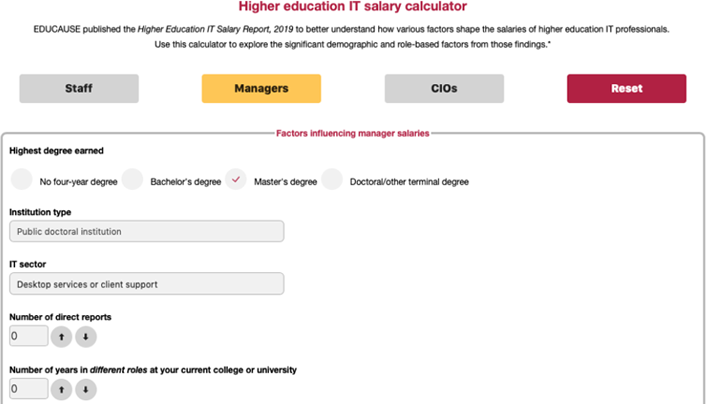The EDUCAUSE Center for Analysis and Research used data from The Higher Education IT Salary Report, 2019 to create a higher education IT workforce interactive salary calculator.

People who work in higher education do so for a variety of reasons, but money isn't typically one of them. Indeed, monetary compensation ranks eleventh among factors keeping higher education IT employees at their current institution—behind such factors as quality of life, work environment, boss and campus leadership, occupational stability, and benefits.1 That said, money does matter. Ideally, our incomes should be a fair reflection of the work we do and should enable us to meet our needs and live comfortably. Higher education IT employees' salaries are competitive even by private-sector standards.2
To better understand how various factors shape the salaries of higher education IT professionals, ECAR published The Higher Education IT Salary Report, 2019.3 In the report, ECAR identified variables that have a statistically significant impact on determining the salaries of IT staff, managers, and CIOs. These variables are related to individual demographics and career paths, characteristics of current positions, and characteristics of current institutions:
- Gender
- Generation (Boomer, Gen X, Millennial)
- Ethnicity
- Education level
- Years of experience in higher education
- Years of experience at current institution
- Years of experience in current position
- Carnegie class
- Presidential cabinet membership (for CIOs)
- Number of direct reports (for managers and CIOs)
- The IT sector in which the individual's position falls (for staff members and managers)

ECAR developed models of higher education IT salary using data gathered from the IT Workforce Survey, 2018. The interactive salary calculator was built to represent the results of those models and allow users to explore the predicted effects of several factors on salary. So, how does it work?
- Select a position of interest. You may choose between staff, manager, and CIO.
- Pick your variables. Choose from a menu of variables that are organizationally appropriate and statistically significant determinants of salary.
- Get your results. Your selections will produce a range of salary values based on actual self-reported salary data collected as part of the IT Workforce Survey, 2018.
- Play again! Reset the interactive to find out the salaries of other positions, and see where you may be able to take your career next!
For more information and analysis about higher education IT research and data, please visit the EDUCAUSE Review Data Bytes blog as well as the EDUCAUSE Center for Analysis and Research.
Notes
- Joe Galanek, Dana C. Gierdowski, and D. Christopher Brooks, The Higher Education IT Workforce Landscape, 2019, research report (Louisville, CO: ECAR, February 2019). ↩
- Ben Shulman and D. Christopher Brooks, The Higher Education IT Salary Report, 2019, research report (Louisville, CO: ECAR, August 2019). ↩
- Ibid. ↩
Kate Roesch is a Data Visualization Specialist at EDUCAUSE.
Ben Shulman is a Statistician at EDUCAUSE.
D. Christopher Brooks is Director of Research at EDUCAUSE.
© 2020 Kate Roesch, Ben Shulman, and D. Christopher Brooks. The text of this work is licensed under a Creative Commons BY-NC-ND 4.0 International License.
